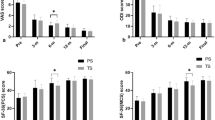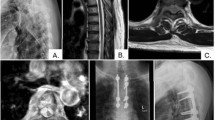Abstract
Internal fixation of fractures of the dorsal-lumbar spine with early ambulation is evaluated in this study of 100 patients with 106 fractures: 34 being treated by recumbency, 13 with Meurig-Williams plates, and 59 with Harrington rods. Fracture reduction in the recumbent group was 14 per cent unsatisfactory, 82 per cent satisfactory, and only one case anatomical. Following plating, 38 per cent were unsatisfactory and 61 per cent satisfactory. Harrington rod reduction and internal fixation resulted in 67 per cent anatomical, 31 per cent satisfactory, and 2 per cent unsatisfactory. Neurologic improvement in partial lesions was 53 per cent with Harrington rods and 44 per cent with recumbent treatment. For paraplegic patients the time required for wheelchair ambulation was reduced from 10.5 weeks with recumbent treatment to 5.3 weeks with Harrington instrumentation. Ambulatory candidate rehabilitation time was decreased from 7.1 weeks to 2.5 weeks. Complications were reduced from 18 per cent in the recumbent group to 7 per cent in the Harrington rod group. By using the three above-three below, rod long-fuse short approach rather than the two above-two below with fusion over the length of the rods technique, the number of anatomical reductions was increased from 70 per cent to 82 per cent and the length of the fusion decreased from 4.8 levels to 1.4 levels.
Similar content being viewed by others
Log in or create a free account to read this content
Gain free access to this article, as well as selected content from this journal and more on nature.com
or
References
Bedbrook, G M (1975). Treatment of thoracolumbar dislocation and fractures with paraplegia. Clin. Orthop., 112, 27.
Bradford, D S, Akbarnia, B A & Winter, R B (1977). Surgical stabilization of fracture and fracture dislocations of the thoracic spine. Spine, 2, 185–196.
Convery, F R, Minteer, M A & Smith, R W (1978). Fracture dislocation of the dorsal-lumbar spine. Spine, 3, 160–166.
Dickson, J H, Harrington, P R & Erwin, W D (1978). Results of reduction and stabilization of the severely fractured thoracic and lumbar spine. J. Bone Joint Surgary 60 A, 799–805.
Flesch, J R, Leider, L L & Erickson, D L (1977). Harrington instrumentation and spine fusion for unstable fractures and fracture-dislocation of the thoracic and lumbar spine. J. Bone Joint Surg., 59A, 143–153.
Fountain, S S, Nagel, D A & Jameson, R M (1978). Complications from Harrington distraction rod fixation of fracture dislocation of the spine. Proceedings of Societe Internationale de Chirurgie Orthopedique et de Traumatologic, Kyoto, Japan, p. 182.
Frankel, H C (1969). The value of postural reduction in the initial management of closed injuries of the spine with paraplegia and tetraplegia. Paraplegia, 7, 179.
Grantham, S A, Malberg, M I & Smith, D M (1976). Thoracolumbar spine flexion-distraction injury. Spine, 1, 172–177.
Guttman, L (1969). Spinal deformities in traumatic paraplegics and tetraplegics following surgical procedures. Paraplegia, 7, 38–49.
Holdsworth, F (1970). Review article: Fractures, dislocations, and fracture-dislocations of the spine. J. Bone Joint Surg., 52A, 1534–1551.
Jacobs, R R (1980). Complications of musculoskeletal trauma. In Chap 36, Fracture Treatment and Healing, ed. R. B. Heppenstall. Philadelphia, W. B. Sanders.
Jacobs, R R (1980). A biomechanical basis for treatment of unjuries of the dorso-lumbar spine. In Chap 14, Osteoarthromechanics, ed. D. N. Ghista, Hemisphere McGraw Hill, 1980.
Kaufer, H & Hayes, J T (1966). Lumbar fracture-dislocation. J. Bone Joint Surg., 48A, 712.
Kelly, C R & Rose, D L (1971). Grading the rehabilitation effort. J. Kan. Med. Soc., 72, 154–156.
Kelly, R P & Whitesides, Jr, T E (1968). Treatment of lumbar dorsal fracture-dislocations. Ann. Surg., 67, 705–717.
Lewis, J & Mckibbin, F (1974). The treatment of unstable fracture-dislocations of the thoracolumbar spine accompanied by paraplegia. J. Bone Joint Surg., 56B, 603.
Nash, Jr, C L, Schatzinger, L H, Brown, R H & Brodkey, J (1977). The unstable stable thoracic compression fracture. Spine, 2, 261–265.
Peterson, E W, Armstrong, G W D (1976). Immediate reduction and fixation of major spinal fractures and dislocations as an aid to the recovery of function. Presented at the annual meeting of Neurological Surgeons, San Francisco, California.
Riska, E B (1976). Anterolateral decompression as a treatment of paraplegia following vertebral fracture in the thoracolumbar spine. Int. Orthop., 1, 22–32.
Roaf, R (1960). A study of the mechanics of spinal injuries. J. Bone Joint Surg., 42B, 810–823.
Roberts, J B & Curtiss, P H (1970). Stability of the thoracic and lumbar spine in traumatic paraplegia following fracture or fracture-dislocation. J. Bone Joint Surg., 52A, 1115.
Roberts, P H (1969). Internal metallic splintage in the treatment of traumatic paraplegia. Injury. Brit. J. Accident. Surg., 1, 4–11.
Soreff, J (1977). Assessment of the late results of traumatic compression fractures of the thoracolumbar vertebral bodies. Karolinska Hospital, Stockholm, Sweden, 1977.
Stauffer, E S & Neil, J L (1975). Biomechanical analysis of structural stability of internal fixation in fractures of the thoracolumbar spine. Clin. Orthop., 112, 159–164.
Weiss, M & Bentkowski, Z (1974). Biomechanical study in dynamic spondylodesis of the spine. Clin. Orthop., 103, 199.
Whitesides, Jr, T E & Shah, S G A (1976). On the management of unstable fractures of the thoracolumbar spine: Rationale for use of anterior decompression and fusion and posterior stabilization. Spine, 1, 99–107.
Author information
Authors and Affiliations
Rights and permissions
About this article
Cite this article
Jacobs, R., Asher, M. & Snider, R. Dorso-lumbar spine fractures: recumbent vs. operative treatment. Spinal Cord 18, 358–376 (1980). https://doi.org/10.1038/sc.1980.64
Issue date:
DOI: https://doi.org/10.1038/sc.1980.64
Keywords
This article is cited by
-
Geschichte des Fixateur interne
Der Unfallchirurg (2015)
-
Neurological outcome after surgery for thoracolumbar fractures
European Spine Journal (1994)



